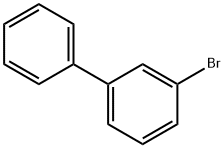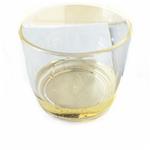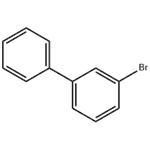Description
3-Bromobiphenyl is an important industrial raw material, but also a very
widely used organic synthesis intermediates, it is widely used in
pharmaceutical, liquid crystal industry and other fields. In recent
years, the export volume of 3-Bromobiphenyl in our country is increasing
day by day, the main export object is some liquid crystal display
production enterprises in Japan and South Korea.
synthesis
Add 1-bromo-3-iodobenzene (4.67 g, 16.5mmol), phenylboronic acid (1.83 g, 15.0 mmol), Pd (OAc)2 (101 mg, 0.450 mmol), PPh3 (239 mg, 0.911 mmol), and K2CO3
(6.23 g, 45.1 mmol) to a 200 mL twonecked round-bottom flask. Add
toluene (40 mL) and water (40 mL) via syringe and reflux the mixture
(bath temp. 100°C) for 24 h. Extract the resulting mixture with ethyl
acetate (30 mL x 3). Dry the combined organic layer over Na2SO4 and concentrate in vacuo. Purify the residue to silica gel column chromatography (eluent:hexane).

Chemical Properties
Colorless to pale yellow liquid
Uses
3-Bromobiphenyl is utilized as an electrochemical immunosensor based on poly(dopamine) coated gold nanocluster for brominated flame retardants.
Definition
T3DB: 3-Monobromobiphenyl is a polybrominated biphenyl. Polybrominated biphenyls (PBBs) are a group of 209 synthetic organic compounds with 1-10 bromine atoms attached to biphenyl. They can be used as flame retardants and may be added to the plastics used to make products like computer monitors, televisions, textiles, and plastic foams to make them difficult to burn. However, the use of PBBs is banned or restricted in most areas due to their toxicity and persistence in the environment.
Synthesis Reference(s)
The Journal of Organic Chemistry, 41, p. 24, 1976
DOI: 10.1021/jo00863a005
General Description
Clear yellow viscous liquid. Insoluble in water.
Air & Water Reactions
Insoluble in water.
Reactivity Profile
3-Bromobiphenyl may be sensitive to light. 3-Bromobiphenyl may react with oxidizing materials.
Fire Hazard
Flash point data for 3-Bromobiphenyl are not available. 3-Bromobiphenyl is probably combustible.
Toxicology
The exact mechanism of toxicty of PBBs varies depending on the specific congener. The predominant interaction is believed to involve the aryl hydrocarbon receptor (AhR). PBBs bind to and activate the AhR, which in turn initiates the transcriptional upregulation of a number of genes, affecting biochemical and endocrine pathways, cell cycle regulation, morphogenesis, oxidative stress response, and various other processes. This results in the numerous toxic responses characteristic of PBBs. Some of the known induced genes include the cytochrome P-450-dependent monooxygenases CYP1A1 and CYP1A2.
Research
3-Bromobiphenyl could be prepared by irradiation of 3,4-dibromobiphenyl (BpBr2) in acetonitrile. At present, a variety of detection methods have been developed to detect its concentration. Such as the electrochemical immunoassay of 3-BBP based on the
PDOP/PB/CMK-3 platform and the multi-HRP–DHCNTs–Ab2 signal
label. This detection method can detect the concentration of 3-Bromobiphenyl in the environment (This study takes river water from the estuary of the Pearl River as sample solvent)[1-2].
References
[1] Sun Z, et al. Electrochemical immunosensor based on hydrophilic
polydopamine-coated prussian blue-mesoporous carbon
for the rapid screening of 3-bromobiphenyl. Biosensors and Bioelectronics, 2014; 59: 99-105.
[2] Peter K, et al.The photochemistry of polyhaloarenes XIII. The photohydrodehalogenation of 3,4-dibromobiphenyl. Tetrahedron, 1996; 52: 8397-8406.







